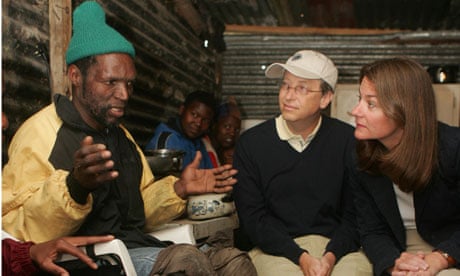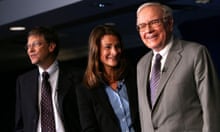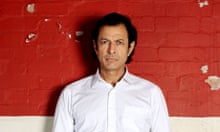The headquarters of probably the most powerful charity in the world, and one of the most quietly influential international organisations of any sort, currently stand between a derelict restaurant and a row of elderly car repair businesses. Gentrification has yet to fully colonise this section of the Seattle waterfront, and even the actual premises of the Bill & Melinda Gates Foundation, which, appropriately perhaps, used to be a cheque-processing plant, retain a certain workaday drabness. Only four storeys high, with long rows of windows but no hint of corporate gloss, its beige and grey box sits anonymously in the drizzly northern Pacific light.
There is no sign outside the building. There is not even an entrance from the street. Instead, visitors must take a side road, stop at a separate gatehouse, also unmarked, and introduce themselves to a security guard, of the eerily polite and low-key kind employed by ex-heads of state and the extremely rich. Once admitted, you cross a car park full of modest vehicles and, if you are lucky, glimpse one of the world-renowned health or poverty specialists working for the foundation, dressed in the confidently casual Seattle office uniform of chinos and rainproofs. Then you reach the reception: finally, there is a small foundation logo on the wall, and beside it a few lyrical photographs of children and farmers in much dustier and less prosperous places than Seattle. Only past the reception, almost hidden away on a landing, is there a reminder of the foundation's status and contacts: a vivid shirt in a glass case, presented during a visit by Nelson Mandela.
The low-lit corridors beyond have little of the scruffiness and bustle you often find at charities. The fast- expanding foundation staff (presently around 850 employees) are in increasing demand around the world: meeting governments, attending summits and conferences, and above all "in the field", as foundation people put it, checking on the progress of the hundreds of projects – from drought-tolerant seeds to malaria vaccines to telephone banking for the developing world – to which the organisation has given grants since it was founded in 1994.
In Seattle, maps of Africa and southern Asia, the foundation's main areas of activity outside America, are pinned up in the often empty, sparsely decorated offices and cubicles. There are also cuttings about the foundation's work from the Economist and the Wall Street Journal, not publications you might have previously associated with a big interest in global disease and poverty. And lying on the foundation's standard-issue, utilitarian desks, there are its confidently written and comprehensively illustrated reports: Ghana: An Overall Success Story is the title of one left in the unoccupied office I have been lent between interviews.
The foundation, in short, feels like a combination of a leftish thinktank, an elite management consultancy and a hastily expanding internet start-up. Is it the sort of institution that can really help the world's poorest people?
For 14 of the last 16 years Bill Gates has been the richest person on earth. More than a decade ago, he decided to start handing over the "large majority" of his wealth – currently £36bn – for the foundation to distribute, so that "the people with the most urgent needs and the fewest champions" in the world, as he and his wife Melinda put it on the foundation website, "grow up healthier, get a better education, and gain the power to lift themselves out of poverty". In 2006, Warren Buffett, currently the third richest person in the world, announced that he too would give a large proportion of his assets to the foundation. Its latest accounts show an endowment of £24bn, making it the world's largest private foundation. It is committed to spending the entire endowment within 50 years of Bill and Melinda Gates's deaths. Last year it awarded grants totalling £2bn.
As well as its money, it is the organisation's optimism and the fame of its main funder – in 2008 Bill Gates stopped working full-time for his computer giant Microsoft to concentrate on the foundation – that has given it momentum. Last May an editorial in the revered medical journal the Lancet praised it for giving "a massive boost to global health funding . . . The Foundation has challenged the world to think big and to be more ambitious about what can be done to save lives in low-income settings. The Foundation has added renewed dynamism, credibility, and attractiveness to global health [as a cause]."
Precise effects of big charity projects can be hard to measure, especially over a relatively short period. But already two bodies that the foundation funds heavily, the Global Alliance for Vaccines and Immunisation (Gavi) and the Global Fund to Fight HIV/Aids, Tuberculosis and Malaria, have, according to the foundation, delivered vaccines to more than 250 million children in poor countries and prevented more than an estimated five million deaths.
"The foundation has brought a new vigour," says Michael Edwards, a veteran charity commentator and usually a critic of billionaire philanthropists. "The charity sector can almost disempower itself; be too gloomy about things . . . Gates offers more of a positive story. He is a role model for other philanthropists, and he is the biggest."
"Everyone follows the Gates foundation's lead," says someone at a longer-established charity who prefers not to be named. "It feels like they're everywhere. Every conference I go to, they're there. Every study that comes out, they're part of. They have the ear of any [national] leadership they want to speak to. Politicians attach themselves to Gates to get PR. Everyone loves to have a meeting with Gates. No institution would refuse."
The foundation has branch offices in Washington DC, Delhi and Beijing. This year, it opened an office in London, not in one of the scruffy inner suburbs usually inhabited by charities, but close to the Houses of Parliament.
Seth Berkley, head of the International Aids Vaccine Initiative [IAVI], says: "The foundation has the advantage of speed and flexibility. When they want to, they can move quickly, unlike many other large bureaucracies. Most of the other private foundations in the US don't work globally. Others are more staid than Gates. I used to work at the Rockefeller Foundation [an older American charity] and dole out grants in small amounts. The Gates foundation gave us at IAVI a grant of $1.5m (£1m), then $25m. Then they gave us a line of credit – which is extremely unusual in grant-making – of $100m, to give us assets to be able to negotiate with pharmaceutical companies and initiate vaccine development programmes. Using that $100m, we were able to leverage lots more funding – $800m in total. What Gates allowed us to do was go out and search for new ideas and move quickly on them. The old way was to find the new ideas, and then look for a donor to back them."
Besides its dizzying grants, the foundation is also becoming a magnet for talented staff and collaborators. "We probably get more than our fair share of great external expertise and insight," says chief executive Jeff Raikes. foundation staff can have a certain self-assurance. When the history of global health is written, says Katherine Kreiss, the foundation officer overseeing its nutrition projects, "the start of the Gates foundation will absolutely be a seminal moment."
Some have reservations about this power and the use made of it. Mindful of the foundation's ubiquity, few in the charity world are prepared to criticise it on the record. But last May the Lancet published two authored articles on the foundation. "Grant-making by the Gates foundation," concluded one, "seems to be largely managed through an informal system of personal networks and relationships rather than by a more transparent process based on independent and technical peer review." The other article found that, "The research funding of the Foundation is heavily weighted towards the development of new vaccines and drugs, much of it high risk and even if successful likely to take at least the 20 years which Gates has targeted for halving child mortality."
In a forthcoming article for the Journal of Law, Medicine & Ethics, Devi Sridhar, a global health specialist at Oxford University, describes as a "particularly serious problem" the "loss of health workers from the public sector to better funded NGOs offering better remuneration". She also suggests that the foundation, like other health organisations based in rich countries but active in the poor southern hemisphere, "[has] tended to fund . . . a large and costly global health bureaucracy and technocracy based in the north". The foundation responds, "Much of our grant-making goes to large intermediary partners that in turn provide funding and support to those doing the work in the field, often to developing country institutions. We're not able to provide a simple funding breakdown."
The rise of the foundation has been part of a larger revival of interest in the west in the problems of poor countries. This phenomenon has encompassed increased government aid budgets, initiatives by the World Health Organisation and World Bank, celebrity-led events and campaigns such as Live8, image-conscious corporate schemes, and countless private ventures, from the sober and long-term to the reactive, adventure-seeking, self-styled "extreme humanitarianism" currently being practised in Haiti by freelance American volunteers and breathlessly described in the July issue of Vanity Fair.
It is hard to see this explosion of activity as a wholly bad thing. But it does have political implications. "It's kind of [creating] a post-UN world," says someone close to the Gates foundation. "People have gotten interested in fast results." The UN, he says, is too slow and bureaucratic – you could say democratic – to achieve them. Critics of the new, more entrepreneurial aid industry such as the Dutch journalist Linda Polman, in her recent book War Games: The Story of Aid and War in Modern Times, see empire-building and wasteful competition as well as worthwhile altruism. "Everyone in global health is talking about poor coordination," says someone at a charity in that field. "The Gates foundation is contributing to the fragmentation and duplication."
And finally, a suspicion lingers, slowly fading but still there, that the foundation's activities are some sort of penance for Gates's world-dominating behaviour at Microsoft – or a continuation of that world domination by other means. Both Raikes and his predecessor as foundation chief executive were at Microsoft; Raikes from 1981 to 2008, during which time he was the company's key figure after Gates and his co-founder Paul Allen.
As Raikes sits in his office, a little messy-haired, dressed in a zip-up jumper, fidgety in his chair and brisk in his answers, he even seems a bit like Gates. "There are some real cultural differences between the Gates foundation and Microsoft," he says. "Some of that's good and some of that's not so good. The foundation is in a stage of . . . maturation. In philanthropy there is kind of a culture of, [he puts on a slightly airy-fairy voice] 'You and I are here to help the world, and so we can't disagree.' At Microsoft, people would really throw themselves into the fray. I'm trying to encourage that here."
He offers only limited reassurance to those who consider the foundation too powerful. "We're not replacing the UN," he says. "But some people would say we're a new form of multilateral organisation." Is the foundation too ubiquitous? He smiles: "There are many people who want us to be much more involved than we want."
Since Raikes joined the foundation in 2008, it has nevertheless broadened its activities. "Today we focus in on 25 key areas," he says, then starts ticking them off on his strong fingers: "Eradicate malaria. Eradicate polio. Reduce the burden of HIV, tuberculosis, diarrhoea, pneumonia . . ." Why not concentrate on fewer of these huge tasks? "You might say it's a little bit of a business way of doing things. There are limits to the amount of money we could invest in any given area." The foundation has so much money, it worries about saturating particular areas of need with grants and so achieving diminishing returns. Instead, says Raikes, "We think dollars-per-Daly in a big way."
Daly is an acronym for disability-adjusted life year, an increasingly common term in international aid and global health circles, which measures the number of years of healthy life lost to either severe illness or disability or premature death in a given population. The idea that suffering and its alleviation can be measured with some precision is characteristic of the foundation's technocratic, optimistic thinking.
The charity also seeks to maximise its impact though partnerships. It does not, for example, conduct medical research or distribute vaccines itself; instead it gives grants to those it considers the best specialists: "We think of ourselves as catalytic philanthropists," says Raikes. He confirms the widely held view – sometimes meant as a criticism – that the health solutions the foundation favours are usually technical: "The foundation is really oriented towards the science and technology way of thinking. We're not really the organisation that's involved in bed-nets for malaria. We're much more involved in finding a vaccine."
The foundation's health strategy is undergoing an internal review led by Girindre Beeharry, a pin-sharp youngish man from Mauritius who studied economics at the Sorbonne and Oxford. "The iconic story we all tell about the foundation," he says, "is, if you had been in polio [medicine] 50 years ago, and your only instrument [to combat it] had been the iron lung, the orthodox approach would have been, 'How can we distribute iron lungs to Africa?' Or you could have spent some of your dollars on developing a polio vaccine – which is how we think."
Ignacio Mas, another fast-talking foundation man who did his economics at Harvard and specialises in financial services for the poor, adds: "If you have this mindset of finding big solutions for big problems, that means technology, in practical terms. Because that is really the only thing that can transform."
Aware of how much they have already changed the world through their businesses, computer tycoons can turn into impatient broader reformers. Google co-founder Sergey Brin is currently funding an attempt to revolutionise the search for a cure for Parkinson's disease. Gates himself grew up in a charity-conscious environment: his mother Mary, a teacher, and his father William H Gates Sr, a well-connected Seattle lawyer, were both active in United Way, the international community service organisation. The Gates family were prosperous, and lived in the hushed and idyllic suburb of Laurelhurst, but Seattle is an outward-looking, conscientious place: in the 1980s Mary led a successful campaign to persuade the local university to withdraw its investments from apartheid South Africa.
By the early 90s, Bill Gates had started giving money to local schools and charities. But the donations were small compared to the billions he was earning, and he was too focused on Microsoft to pay much attention to the growing number of begging letters that his wealth and fame attracted. His parents, privately, and Seattle journalists, publicly, began to suggest that he should be more civic-minded. Then in 1995 he published The Road Ahead, a book he had co-written about the future of computing. Its sometimes bland corporate prose, Microsoft's domineering reputation and Gates' then unloved public persona meant that it received mixed reviews. Yet, read now, with the subsequent establishment of the foundation in mind, the book contains striking digressions about the world's "sociological problems" and "the gap between the have and have-not nations". There is a sense of Gates becoming curious about the world's non-software needs and how he might help address them.
In 1994 he and his father had set up the William H Gates Foundation. Gates Sr ran it from his basement. Gates Jr wrote the cheques. The causes he backed were broader than before: birth control and reproductive health. As the foundation expanded, he and Melinda, whom he had met at Microsoft, both found themselves becoming more and more interested in the wider world. "I started to learn about poor countries and health, and got drawn in," Gates told students at Berkeley during a speaking tour this spring. "I saw the childhood death statistics. I said, 'Boy, is this terrible!'"
Gates has a tendency to talk about the horrors and injustices of the developing world just as he talks about the computer business: in blunt, jerky sentences, his nasal voice flat or leaping, his manner without much natural warmth or charm. He sounds like a clever man in a hurry thinking out loud – which is exactly what he is. Starting in the late 90s, he began to hungrily chew through the expert literature on global disease and nutrition and poverty. "He is a giant sponge," says an epidemiologist who specialises in HIV. "I had dinner with him a couple of weeks ago. The man is extraordinary. I've been in the field 15 years, and his grasp of the technical details is just astounding. His weird brain allows him to ask questions."
In 1999 the William H Gates Foundation and a separate charity Bill Gates had established to improve computer access in American libraries were combined into the Bill & Melinda Gates Foundation. As the couple grew richer through Microsoft, so they started making intermittent donations to a trust (from 2006 known as the Bill & Melinda Gates Foundation Asset Trust), which invested the accumulating assets. Those in turn were donated to the foundation.
"In the early days, it was crazy," says Katharine Kreiss, who joined from the American foreign service in 2002 and is refreshingly less on-message than more recent recruits. "There were so few people. I was one of 17 in total covering global health. By law in the US, as a charity you have to spend 5% of your endowment [annually], so you're always trying to meet this number. When I started, we gave out about $1.5bn, the same as my department had when I was in the government, where I think we had a staff of 4,000! When I came into the foundation, I had 172 grants I was working on. There weren't the people to do the rigour. We have so changed since. Now I have eight grants and I'm overwhelmed. I'm working on them in a much more detailed way."
Gates is also much more involved. Since 2008 he and Melinda have begun regularly visiting the foreign projects it supports. "About 18 to 24 months in advance, they're thinking about what trips they might go on," says Kreiss. "Then they winnow down the options. We send them briefing notes. It's really like working with a high-level principal in the government. If it's your project, you will probably do an advance trip or two. Bill and Melinda will send their own advance team to look at logistics." Then, sometimes accompanied by one or two carefully chosen journalists, the world's second richest couple will visit homes or clinics in some of the world's most blighted regions. "I've never actually been on a trip with Bill and Melinda," says Kreiss. "But there are many questions. I've heard it's just nonstop questions. There's no downtime. Not a minute. It's not a vacation."
When they are back in Seattle, where they still live, Bill and Melinda have the use of offices at the foundation on a secluded top-floor corridor, along with Raikes and Gates Sr. This part of the building is slightly plusher – there are lights concealed in pillars and one corridor wall is an expensive-looking gold colour - but it is hardly palatial. Bill Gates's status is denoted by something subtler: the sudden care with which foundation staff from Raikes downwards start choosing their words when the subject of Gates and his wife comes up. "The foundation is their vision, their mission," says Kreiss. Roy Steiner, the foundation's deputy director for agriculture (Harvard, ex-management consultant), tells me: "Bill has just recently spent a night in an Indian village. He slept in a hut in a village. How many chairs of philanthropic organisations have done that? But he's a business guy – he wants to understand the customer."
Outsiders who work with the foundation are sometimes less enthusiastic about his role. "Everyone in that organisation spends their whole time second-guessing what Bill will say," says one. "They've got very smart people, but they're always waiting for Bill." According to the foundation, Gates and his wife "review" only its grants that exceed $50m, but Bill Gates's influence can also be felt in much smaller foundation matters. Recently, an academic paper covering an area in which the charity is highly active, written by someone Gates knew quite well, was held back from him by foundation staff. "We can't show it to him," the author of the paper was told. "We think he won't like it. The problem is the title of the paper. It includes a word Bill is allergic to."
Yet sometimes, the author continues, Gates is more open-minded than his subordinates anticipate: "If you can capture his imagination, he will listen to any idea. He's willing to say, 'Let's look at this.'" This year, alongside the foundation's slick official website, a quirkier and more personal one began appearing called the Gates Notes, with sections called "What I'm Thinking About", "What I'm Learning" and "My Travels", and musings and recommendations on green technology, the financial crisis and the computer business as well as on the foundation's existing activities. There is a sense of Gates, still only 54 and liberated from his round-the-clock Microsoft duties, constantly roaming beyond his charity's already vast boundaries. The internet, the modern power of celebrity, and the ease of travel to virtually anywhere in the world enjoyed by the super-rich, has made it possible for the more thoughtful, socially conscious of them – such as Gates and the financier George Soros – to become autodidacts and philosopher-kings more potent even than the last generation of famous philanthropists, such as Andrew Carnegie and John D Rockefeller.
Last May, Gates, Soros, Buffett and David Rockefeller Jr, Rockefeller's great-grandson, held a long private meeting in New York, not far from the UN, along with an assortment of media potentates such as Ted Turner, Oprah Winfrey and Michael Bloomberg. It was reported that Gates had been involved in summoning them all together; and that the Good Club, as it supposedly called itself, discussed the world's economic, environmental and health problems, the dangers of over-population, and how rich people could better help poor people. The Sunday Times quoted an unnamed participant at the meeting, who said that without anything "as crude as a vote" the gathering had agreed that the world's problems "need big-brain answers . . . independent of government".
For the internet's many Gates-watchers and conspiracy-spotters, it was all irresistibly sinister. Last month an apparently more benign explanation appeared. A friend of Gates and Buffett, Carol Loomis, wrote in the tycoon-watchers' magazine Fortune that the gathering had been part of a behind-the-scenes campaign by the two men and Melinda Gates, which was now ready to go public, to persuade the rest of America's billionaires to pledge at least 50% of their wealth to charity.
Like the Gates foundation, the initiative seems laudable and refreshing in many ways – especially given the discarding of any sense of social responsibility by so many of the rich in recent decades. Several of America's wealthiest families have already signed the pledge. And yet, some authorities on philanthropy fear the consequences of this giving boom, and dislike the faint air of playing god that hangs over its creations such as the Gates foundation. Edwards says: "The world isn't a giant experiment. The foundation affects real people in real places. Why should Bill decide which sort of vaccines get developed?
"If you read the early reports of the Rockefeller and Carnegie foundations," Edwards goes on, "those organisations have almost exactly the same character as the Gates foundation: top-down, technocratic, applying the language of engineering to social problems." Edwards has worked in the charity sector since 1978, through good times and bad, and he also warns: "You can have boom and bust in this kind of 'philanthrocapitalism' as in capitalism itself." Put crudely, the super-rich need to stay super-rich for their charitable enterprises to function.
The value of the Gates foundation's endowment fell by a fifth during the 2008 banking crisis, although Raikes says the foundation did not cut its grant-making during the downturn, and its finances have recovered since. The ethical basis of the foundation's finances has also been questioned. In 2007 an extensive investigation by the Los Angeles Times found that the charity, via its trust, invests in "companies that contribute to the human suffering in health, housing and social welfare that the foundation is trying to alleviate". The foundation did not challenge the thrust of the articles, which included allegations that it invested in an oil company responsible for causing health problems by burning off its unwanted gas, in an African country in which the foundation was active in trying to improve the population's health. But the charity decided after a brief review not to change its investment policy. Raikes's predecessor Patty Stonesifer wrote to the newspaper: "The stories you told of people who are suffering touched us all. But it is naive to suggest that an individual stockholder can stop that suffering. Changes in our investment practices would have little or no impact on these issues."
The Bill & Melinda Gates Foundation Asset Trust has always refused to invest in tobacco firms; otherwise, the outside investment managers the trust employs are instructed to seek the maximum return on its endowment, so that the foundation can be as generous as possible. It is a moral trade-off; but then uncomfortable compromises, like unequal power relationships, run through most charitable work.
Many of the Gates foundation's critics concede that the organisation is, as Edwards puts it, "closer to the best than the worst" on the spectrum of private charitable foundations: more expertly staffed, more focused on the problems where charity is most needed, more professional – there have so far been no obviously disastrous foundation-funded projects – and more prepared to change as it grows.
Raikes's desire for fiercer internal debates at the foundation may be an acknowledgement that Gates needs to be challenged more. And Gates may want to be challenged more: according to Beeharry, among Gates's current reading is a 2005 group biography of president Abraham Lincoln's inner circle, Team of Rivals by Doris Kearns Goodwin: "Bill think it's the best book ever written. It's about how you embrace dissent as a leader." Lincoln's "genius", writes Goodwin, was "to form friendships with men who had previously opposed him; to repair injured feelings; to assume responsibility for the failures of subordinates; to share credit with ease; and to learn from mistakes." Given his driven decades at Microsoft, it may be hard to imagine Gates being interested in such softer qualities; but then it was hard not so long ago to imagine him giving most of his money away.
Next year the foundation is scheduled to move into new premises. Instead of the present hidden-away headquarters, and two even blander buildings it uses a mile away – staff have to shuttle between them all by minibus – the foundation will occupy a much showier hilltop "campus" in central Seattle, all dark glass and golden stone, with office blocks like ocean liners, space for at least twice the current staff, and a visitor centre the size of a small supermarket for the public to learn about the foundation's good works. On the windows of the unfinished visitor centre, there are quotes from selected thinkers. One is from the famous American anthropologist Margaret Mead: "Never doubt that a small group of thoughtful, committed individuals can change the world; indeed, it's the only thing that ever has."
The way Gates and his elite staff have chosen to try to do so is by running their charity as a kind of business. Edwards calls this approach – increasingly popular at private foundations funded by business-people – philanthrocapitalism; others call it "venture philanthropy". Steiner explains: "Sitting here in Seattle, we're not going to solve Africa's problems. Africans are going to solve Africa's problems. We've got to find the Africans." Often, this means the foundation mounting competitions for grant applications, and giving money to the winners, which usually means the most "pioneering" (Steiner's word) and those that promise to fulfil a need not met by other charities.
Foundation staff describe this process, and indeed all their work, in business-school language: achieving "leverage", building the foundation "brand", serving "markets" and "customers". Or they use the language of management consultancy and computing: "Bill is about numbers," says Steiner. "He wants to see the data. He values data more than ideology."
Like all the foundation staff I meet, Steiner is personable and thoughtful, sitting tieless in his modest office. And like the others, he is both intensely idealistic and close to disdainful about the older, less business-orientated charity models. In his field of agricultural aid, he says, "We need a lot of smarter ways of doing things. We can't do things the same old way . . . The people who've been in the field for so long [for other charities] don't embrace how much transformation can happen. You walk in there as clear-eyed as you can . . . And [you] are basically optimistic that people want to improve their lives. You enable them with technology and knowledge, and great and wonderful things can happen."
He looks into the middle distance as the soft Seattle summer drizzle hangs outside his window. With his strong gaze and open-necked striped shirt, his shelves crammed with agriculture books and box files, his line of jars filled with brightly coloured seeds on a table against the wall, and his slightly impatient body language, as if just about to set off on another of his frequent trips to Africa or Asia, he seems a little like a high-minded Victorian explorer.
But Steiner and his colleagues are probably more aware of their limitations. There is a problem with the Gates foundation that its staff, for the time being, appear to grasp better than its critics. For all the charity's resources and connections, for all the attendant risks of over-confidence and over-mightiness, on the ground in Africa or Asia the foundation's immense-sounding grants are a miniscule fraction of what is required to create a fairer world. "In agriculture," says Steiner, "the problem's this big" – he throws out his long arms – "and our resources are this big" – he pinches an inch of air between a finger and thumb. With an ex-management consultant's preciseness, he concludes: "We estimate we can probably be 3-5% of the overall solution."
Then he abruptly gets up from the meeting table, turns away from me without a goodbye handshake, and goes back to his desk and computer. At the Gates foundation, they are very keen that meetings do not overrun. There is much work to be done.








Comments (…)
Sign in or create your Guardian account to join the discussion